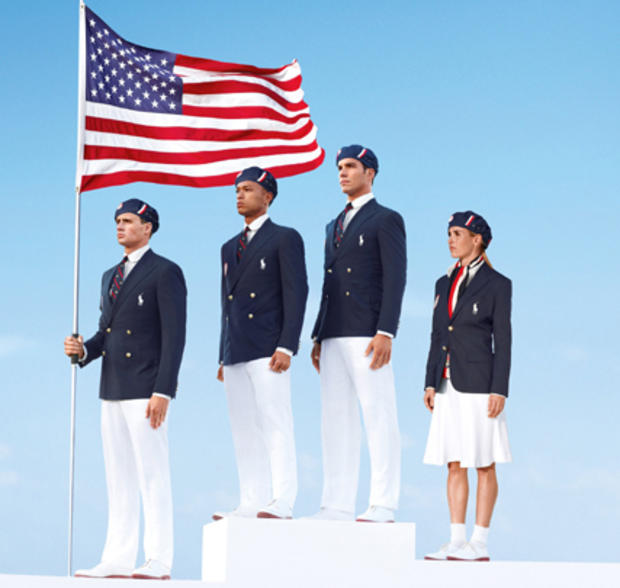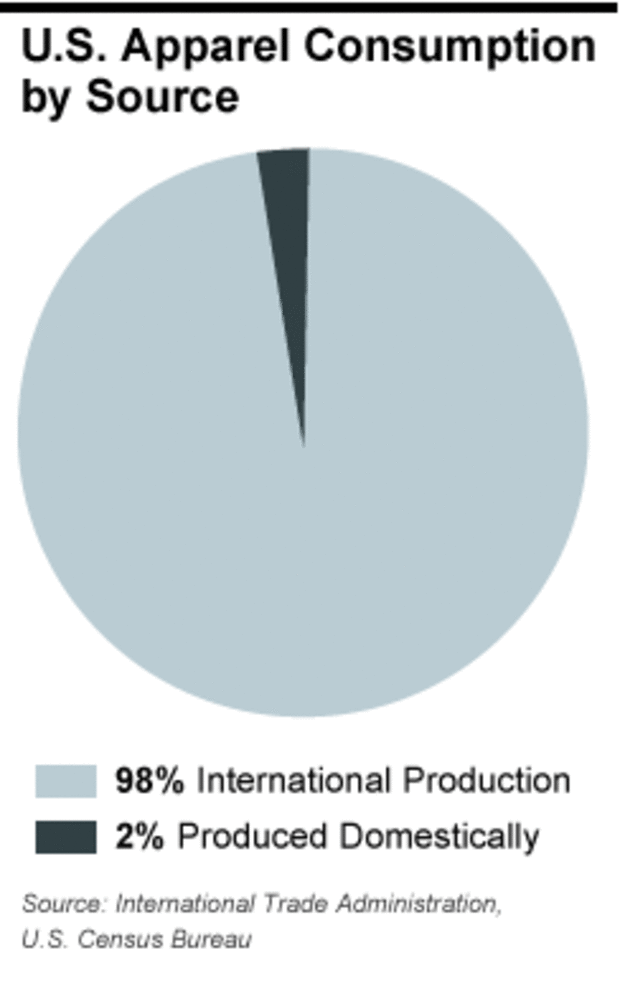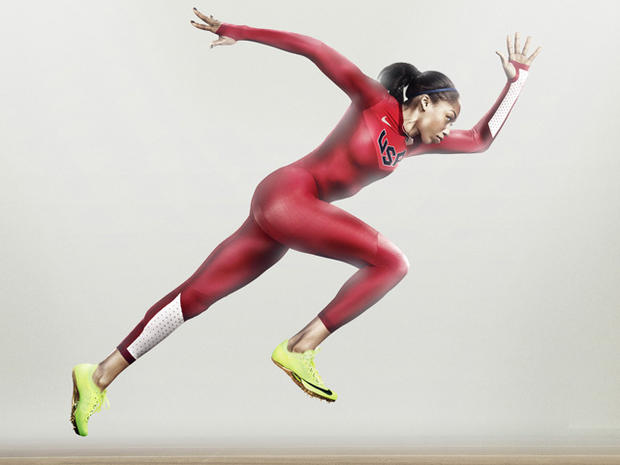Should Olympic uniforms be made in the U.S.?
(CBS News) If Harry Reid had his way, America's 530 Olympic athletes would toss out their Chinese-made Ralph Lauren suits and trot out during Friday's opening ceremony in hand-painted singlets. Why should our athletes, the Senate leader and others wondered, wear foreign-produced uniforms when so many Americans are looking for work and would gladly make them?
Reid can at least rest assured that starting in 2014, the U.S. Olympic opening ceremony uniforms will not only be designed domestically but also made in the U.S.A. After two weeks of controversy and threats of legislative action from Congress, Ralph Lauren and later the U.S. Olympic Committee committed to making future opening ceremony uniforms in the United States.
To some, Congress' complaints about the production of the uniforms came across as grandstanding, and it's easy to understand why: "Making one set of Olympic uniforms does not a manufacturing base create," quipped Heather Boushey, a senior economist for the liberal Center for American Progress. Still, she added, "This debate about 'Made in America' is a profoundly important debate to be having, and if this is a way to have that conversation, then let's do that."
Sen. Robert Menendez, D-N.J, who met with the Olympic Committee to secure their commitment, insists the controversy was about more than just a "conversation."
"There are domestic manufacturers, including New Jersey companies, who want to compete to make these uniforms," Menendez told CBSNews.com. "I am confident that they can compete on quality and price and attire our Olympic athletes in ceremonial uniforms made in America, by Americans."
For both political and policy reasons, domestic manufacturing matters significantly. The nation's manufacturing base has helped build up a strong middle class and is the foundation of an innovative and growing economy. And with millions of Americans looking for work, there's no better election-year promise than that of factory floors springing back to life. It's not surprising, then, that congressional Democrats have an entire initiative called Make It In America, that President Obama and Mitt Romney regularly campaign at factories, or that lawmakers were up in arms over the production of the Olympic uniforms.
Democrats and Republicans agree on some ways to boost manufacturing, like lowering the marginal corporate tax rate, but they are diametrically opposed on other big changes, like taxing outsourcers. While they hash out those issues, Congress is working on other, more low-profile ways to boost apparel manufacturing -- even though it may seem like a lost cause.
As Dan Ikenson of the libertarian think tank the Cato Institute said of the Olympic uproar, "We just don't cut and sew clothing in the U.S. anymore... so why should we make a big stink about this?"
Indeed, textiles and apparel manufacturing is traditionally one of the first things to move overseas as a country becomes more developed. So the decline of apparel manufacturing, to a certain degree, represents the ever-growing sophistication of the United States economy and its role in the global market.
Where are the jobs?
Manufacturing as a share of the economy has been shrinking since 1979, but it's been growing in absolute terms. The narrative that the U.S. doesn't "make things" anymore simply isn't true. Most of the items made in America, however, aren't obvious retail items -- the U.S. now makes airplanes and pharmaceuticals instead of clothes or hand tools.
"The idea that manufacturing is hurting is misplaced," Ikenson said. "What people are really hinting at is that it doesn't employ as many people as it used to, and that is true."
That's especially true in apparel manufacturing, in which employment has declined by more than 80 percent (from about 900,000 to 150,000 jobs) over the past two decades.
Aside from a couple of specific markets -- for instance, U.S. military uniforms and some high-end men's footwear -- domestic apparel manufacturing is virtually nonexistent. According to the American Apparel & Footwear Association, just 2 percent of U.S. apparel was produced domestically in 2010. China was the dominant supplier, accounting for about 34 percent of clothes sold in the U.S.
While few Americans are cutting or sewing clothes, Ikenson noted that the apparel industry still employs plenty of Americans. From designing, branding, logistics and retailing, he said, "there are a lot of jobs involved in the act of getting a piece of clothing out of the mind of a fashion designer and onto the bodies of Americans."
Reviving the apparel manufacturing industry
Nevertheless, Menendez and other lawmakers are trying to do more for domestic apparel manufacturing than getting a few Olympic uniforms made. Recently, the Senate Finance Committee approved Menendez's Cotton Trust Fund legislation, which would correct a tarriff inversion that makes it cheaper for companies to import a foreign-made shirt than to import raw shirting fabrics. Menendez says the bill could protect as many as 10,000 American jobs and 300 jobs in New Jersey alone, within companies like Gambert Shirts.
The Cotton Trust Fund legislation has some Republican support, giving Menendez a "sliver of hope" that the GOP will work with Democrats on measures to boost manufacturing. Even though, he said, "Time and time again, Senate Republicans have blocked critical pieces of jobs legislation that in the past they would have supported simply because, I believe, they want to see this president fail."
Republican Rep. Tim Murphy of Pennsylvania, another congressman who emphatically protested the foreign production of the Olympic uniform, also said there should be room for agreement on the issue of manufacturing.
"This is more than just symbolism," he said of the uniform controversy. "Behind those labels is a heck of a lot of jobs and real people and real families
Murphy said it's worth reviving a dwindling manufacturing industry, even if there are short-term financial benefits to moving production abroad, because "in the long run when American factories shut down, we no longer have much control over those goods."
That's an especially critical point in growing industries like energy production, Boushey of the Center for American Progress said. The production of batteries, for instance, was long based in Asia. But with the development of electric cars, battery technology has re-emerged as a cutting-edge, lucrative area of research. If those products aren't researched and produced in the U.S., Boushey said, "we are not going to be at the forefront of competitive technology."
Sewing together uniforms may seem like a far cry from developing new energy technologies, but like batteries, apparel may be a once-simple sector evolving into something more sophisticated. European companies are designing and producing air-conditioned bullet-proof vests and jackets designed to fight air pollution. At this year's Olympics, runners will wear Nike's Pro TurboSpeed, a track suit with golf ball-like dimples designed to make it more aerodynamic. Speedo, meanwhile, continues to designcutting edge swimsuits, even after the 2008 controversy.
Deep partisan divides
While the parties may agree on the need to preserve domestic manufacturing, their means of doing so are vastly different.
President Obama, for instance, wants to implement a minimum tax on foreign earnings, so U.S.-based companies have more reason to keep their production at home. Similarly, Senate Democrats recently attempted to pass the Bring Home Jobs Act, a bill that would have given companies a 20 percent tax credit to companies that brought outsourced jobs back to the U.S. The bill also would have eliminated tax deductions for costs associated for moving jobs overseas.
The Bring Home Jobs Act received support from a few Republicans, but the GOP ultimately blocked it, calling it a political stunt. "Not only is this bad for business, but by disallowing deductions for certain business expenses, this proposal would measure income less accurately," Sen. Orrin Hatch, R-Utah, said on the Senate floor. "Ultimately, we know that this bill is devoid of serious content because it is the product of political, not economic, necessity."
Mitt Romney and Republicans oppose Mr. Obama's plan for a minimum tax on foreign earnings, saying the U.S. shouldn't shoulder businesses with more taxes.
"If policymakers want to bring economic activity back, they need to incentivize investment here," Ikenson said, "and they can do so by streamlining the regulations that exist, by overhauling our immigration policy, and basically getting out of the way."




